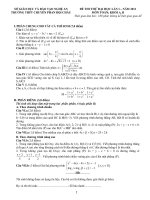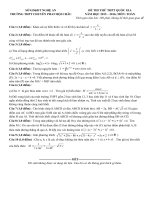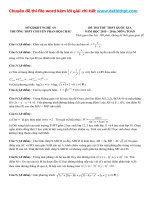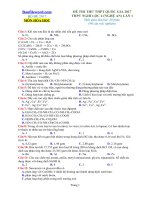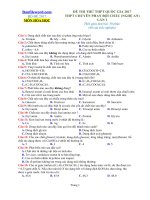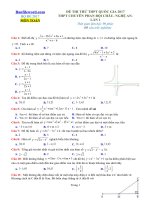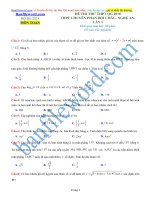20 20 đề thi thử THPT quốc gia 2020 môn anh THPT chuyên phan bội châu nghệ an lần 1 (có lời giải chi tiết)
Bạn đang xem bản rút gọn của tài liệu. Xem và tải ngay bản đầy đủ của tài liệu tại đây (185.63 KB, 17 trang )
SỞ GD & ĐT NGHỆ AN
ĐỀ KHẢO SÁT CHẤT LƯỢNG LỚP 12 LẦN 1
TRƯỜNG THPT CHUYÊN
NĂM HỌC: 2019 – 2020
PHAN BỘI CHÂU
MÔN: TIẾNG ANH
Thời gian làm bài: 60 phút; không kể thời gian phát đề
Mã đề :229
Read the following passage and mark the letter A, B, C, or D to indicate the correct answer to each
of the questions.
Naming customs are different around the world. In most cultures, however, people have at least two
names: a family name and a given name. Your given name is the name you receive when you are born.
Your family name is the name you share with other people in your family. In the United States, the family
name is often called the last name, and the given name is often called the first name. However, the order
of the two names is not the same everywhere. For example, in many Asian countries, the family name is
first and the given name is second. When two people from different cultures meet, sometimes they use the
incorrect name. This can cause embarrassment.
Family names can show something about a family's early history. The origin of many English
family names is a place, like London, or a job, such as Farmer or Shoemaker. A long time ago, these
families probably worked as farmers or shoemakers. Swedish and Danish family names often mean son
of. For example, Johansson means son of Johan. In South Korea, there are only about 250 family names.
These names go back hundreds of years to very old clans. About half of all Koreans have one of the three
most common family names - Kim, Park, or Lee.
There is generally no choice about a family name, but there is much more choice about given
names. Parents choose their child's name for many different reasons. They may select a name that sounds
beautiful or means something special. These names may have meanings like peace or happiness. In some
cultures, there may be a connection between children's names and when or how they were born. For
example, a Yoruba child in Nigeria might have a name like Sunday or Born on a Sunny Day. In some
countries, parents may pay money to a professional baby namer to help them find a good name. They
want to find a name that will be lucky for their child.
(Source: Jessica William, Making Connection 1, 2nd Ed., Cambridge, 2014)
Câu 1 (TH): It is stated in the first paragraph that when two people from different cultures meet,
________.
A. they do not know how to say their names
B. they very often misaddress each other
C. they may misuse each other's names
D. they will misunderstand each other
Câu 2 (TH): What is NOT mentioned as a reason for parents to choose names for their child?
A. a name that shows how a child is born
B. a name that brings strength to their child
C. a name that means something special
D. a name that will be lucky for their child
Câu 3 (VD): Which of the following statements can be inferred from the passage?
Trang 1
A. Naming is a universal culture.
B. People can choose their own names.
C. Names are selected in accordance with local customs.
D. People can change their lives by changing names.
Câu 4 (VD): What does the word "clans" in the passage mostly mean?
A. a number of royal families
B. large groups of families
C. upper class families
D. lower class families
Câu 5 (TH): What can be the best title of the reading passage?
A. Naming for a reason
B. Naming for Fun
C. Beautiful Names
D. Naming Customs
Mark the letter A, B, C, or D on your answer sheet to indicate the underlined part that needs
correction in each of the following questions.
Câu 6 (VD): The company will make some research on the domestic market and put forward a proposal
to promote sales.
A. will make
B. on the domestic
C. put forward
D. promote sales
Câu 7 (VD): Globally and internationally, the 1990's stood out as the warmest decade in the history of
weather records.
A. Globally and internationally
B. out
C. warmest
D. weather records
Câu 8 (TH): Tom said that if he had to do another homework tonight, he would not be able to attend the
concert.
A. if he had to
B. another
C. would not be able
D. to attend
Mark the letter A, B, C, or D on your answer sheet to indicate the sentence that best combines pair
of sentences in the following questions.
Câu 9 (VD): It's not fair to put all the blame on him. He's not the only one at fault.
A. Only the one who were involved should be punished.
B. He deserved to be punished, but the others don't.
C. It wouldn't be right to punish those who, like him, were not involved.
D. He doesn't deserve to be blamed for everything as there were others involved.
Câu 10 (VD): Increasing urbanization has led to problems. Cities are centers of civilization and culture.
A. Despite increasing urbanization has led to problems but cities are centers of civilization and culture.
B. In spite of increasing urbanization has led to problems but cities are centers of civilization and
culture.
C. Although increasing urbanization has led to problems but cities are centers of civilization and
culture.
D. Though increasing urbanization has led to problems, cities are centers of civilization and culture.
Trang 2
Mark the letter A, B, C, or D on your answer sheet to indicate the word that differs from the other
three in the position of primary stress in each of the following questions.
Câu 11 (TH):
A. determine
B. rearrange
C. develop
D. distinguish
Câu 12 (TH):
A. ostentatious
B. uncontrollable
C. competitively
D. controversial
Read the following passage and mark the letter A, B, C, or D to indicate the correct word or phrase
that best fits each of the numbered blanks.
The idea of going overseas to study can be daunting, with visions of baffling languages or nights
spent in isolation while you are gradually forgotten by your friends and family. (13) ______, the benefits
of studying abroad - such as broadening your mind, improving your career prospects and making friends
from all over the world - can make digging out your passport really rewarding.
"Studying abroad is an eye-opening experience,” says Anna Boyd, event manager at The Student
World. "Being (14) _______ in another culture, understanding differences and spotting similarities, living
on a beach or in the mountains, (15) __________ will have an impact on every student."
Overseas study comes in many shapes and sizes. It might be a single semester abroad via an
Erasmus programme, for example. Or you might elect to follow a full three-or four-year degree
programme. Whatever your ambition, the key is starting early. Some countries require specific
combinations of A-levels from UK students, Germany looks for four A-levels including maths or science
and one modern foreign language, for instance, while others, such as the US, value extracurricular
activities. Starting our research well ahead (16)_______ time can help you make the right choices.
"Getting involved in sports, arts and music is also worth considering, as well as gaining experience
through volunteering and work placements," says Boyd. In fact, applying to study abroad could even
work to your advantage, for example, you might encounter lower (17)________ requirements.
(Adapted from kistudent/study-abroad)
Câu 13 (TH):
A. But
B. Therefore
C. However
D. Thereby
Câu 14 (TH):
A. immersed
B. interested
C. resided
D. taken
Câu 15 (NB):
A. which
B. where
C. why
D. that
Câu 16 (TH):
A. on
B. in
C. of
D. off
Câu 17 (VD):
A. entry
B. entrance
C. enter
D. entered
Mark the letter A, B, C, or D on your answer sheet to indicate the word(s) CLOSEST in meaning to
the underlined word(s) in each of the following questions.
Trả lời cho các câu 18, 19 dưới đây:
Câu 18 (VD): Sometimes, in order to get things done, you have to take the initiative.
A. make the last decision
B. make important changes
C. raise the first idea
D. sacrifice for others
Câu 19 (TH): The emblem of the Association of Southeast Asian Nations was designed basing on rice –
the most important crop for the Southeast Asian people.
Trang 3
A. banner
B. logo
C. motto
D. slogan
Mark the letter A, B, C, or D on your answer sheet to indicate the option that best completes each of
the following exchanges.
Câu 20 (TH): Kathy and Kim are friends. They have just finished lunch in a restaurant.
Kathy: "The food is great. I'll get the bill."
Jim: "_____________”
A. Yes, speak to you soon.
B. No, this is on me.
C. It's nothing.
D. Don't mention it.
Câu 21 (NB): Jane is talking to Billy about the meeting.
Jane: "Is everybody happy with the decision?",
Billy: “____________”
A. That sounds like fun.
B. Yes, it is certainly.
C. No, have you?
D. Not really.
Mark the letter A, B, C, or D on your answer sheet to indicate the word(s) OPPOSITE in meaning
to the underlined word(s) in each of the following questions.
Câu 22 (VDC): I've become a bit of a couch potato since I stopped playing football.
A. a lazy person
B. a live wire
C. a kind person
D. a nice person
Câu 23 (VDC): That last comment of yours won the day because nobody could possibly argue with you
after that.
A. was a big hit
B. was a break-through
C. was a success
D. was a failure
Mark the letter A, B, C, or D on your answer sheet to indicate the word whose underlined part
differs from the other three in pronunciation in each of the following questions.
Câu 24 (TH):
A. mood
B. bloom
C. stood
D. groom
Câu 25 (TH):
A. helped
B. advertised
C. finished
D. influenced
Mark the letter A, B, C, or D on your answer sheet to indicate the correct answer to each of the
following questions.
Câu 26 (NB): _______ swimming is considered to be ________ good way of losing weight.
A. The / a
B. Ø / a
C. A/ the
D. The/ the
Câu 27 (VD): _______, they discovered that their house had been burgled.
A. On their return from the trip
B. They had returned from the trip
C. To have returned from the trip
D. After they have returned from the trip
Câu 28 (VD): When he went to Egypt, he knew _______ no Arabic, but within 6 months he had become
extremely fluent.
A. virtually
B. barely
C. entirely
D. scarcely
Câu 29 (TH): _______ young girls think cosmetic surgery is safe, it still carries all the risks of surgery.
Trang 4
A. Despite
B. Since
C. Although
D. Because of
Câu 30 (NB): This time tomorrow ________ on the beach sunbathing and drinking freshly squeezed fruit
juice!
A. I'll have been lying B. I will be lying
C. I'll have lain
D. I will lie
Câu 31 (VDC): That's exactly what I mean, Tom. You've _______.
A. put your foot in it
B. put two and two together
C. killed two birds with one stone
D. hit the nail on the head
Câu 32 (VD): The lottery winner was willing to spend a considerable sum of money to ________ to
charity to help those in need.
A. give away
B. give in
C. give back
D. give up
Câu 33 (VD): The schoolboy's excuse wasn't _______ at all. Nobody in the classroom believed in the farfetched story he told.
A. credential
B. credible
C. credulous
D. creditable
Câu 34 (NB): Having undergone many changes over the years, Ao dai is still worn ________ pride by
Vietnamese women.
A. of
B. with
C. in
D. under
Câu 35 (TH): Lady Gaga would never forget _______ the Best Original Song prize for 'Shallow’.
A. being awarded
B. to have awarded
C. to be awarded
D. having awarded
Câu 36 (TH): Only if I had known the difference __________ the more expensive car.
A. I would have bought
B. would I have bought
C. would I buy
D. would I bought
Câu 37 (TH): _______ only in the Andes, the plant is used by local people to treat skin diseases.
A. Found
B. Having found
C. Finding
D. Founded
Câu 38 (TH): The boy has a collection of ________.
A. valuable Australian old postage stamp
B. old valuable Australian postage stamp
C. valuable old Australian postage stamp
D. old Australian valuable postage stamp
Câu 39 (VD): According to new regulations, car drivers will be fined up to VNÐ 30-40 million (US
dollar 1.297-1.729) and have their driving license _______ for 22-24 months if they are caught driving
under the influence of alcohol.
A. taken
B. validated
C. revoked
D. ratified
Mark the letter A, B, C or D on your answer sheet to indicate the sentence that is closest in meaning
to each of the following questions.
Câu 40 (VDC): There is no point in your phoning Jane – she’s away.
A. It would be a waste of time phoning Jane - she's away.
B. Don't spend your valuable time phoning Jane - she's out.
C. Jane is very difficult to phone - she's always away.
Trang 5
D. You waste your time if you insist on phoning Jane - she's away.
Câu 41 (VDC): My eldest sister started working as a freelance journalist as soon as she graduated from
university.
A. Hardly had my eldest started working as a freelance journalist when she graduated from university.
B. No sooner had my eldest sister graduated from university than she started working as a freelance
journalist.
C. No sooner had my eldest sister started working as a freelance journalist than she graduated from
university.
D. After my eldest sister graduated from university, she had started working as a freelance journalist.
Câu 42 (TH): She reminded her daughter of the table manners.
A. She wanted her daughter to be more polite while eating.
B. She wanted her daughter to eat a little more slowly.
C. She wanted her daughter to leave the dinner table.
D. She wanted her daughter to remember all meal time.
Read the following passage and mark the letter A, B, C, or D to indicate the correct answer to each
of the questions.
Mark Zuckerberg was born in 1984, in New York, into a prosperous, professional family. He
developed an interest in computers at an early age and when he was twelve, created a messaging program
which he named "Zucknet". His dentist father used it in his surgery so that his receptionist could inform
him of the arrival of a patient without yelling across the room. Together with his friends, Mark spent
much of his spare time as a boy designing and making computer games just for fun.
In 2002, Mark enrolled at Harvard University. By his second year at the institution, he had acquired
a reputation on the campus as a developer of software. It was at that time he invented "Facemash" which
compared pictures of female students and allowed users to vote on which one was the most attractive. The
program became very popular on campus, but was later shut down by the university authorities who
deemed it "inappropriate".
Based on the buzz of "Facemash", three of Mark's fellow students, Divya Narendra, and twins,
Cameron and Tyler Winklevoss, asked him to work with them on an idea for a social networking site
called "Harvard Connection". This site was designed to use information from Harvard's student networks
to create a dating site for the university's elite. Mark was initially enthusiastic about the complex project
but boredom soon set in and he backed out of it to work on his own social networking site. He created a
site that allowed users to produce their profiles, upload photos, and communicate with other people
beyond the confines of the university. He called the site "Facebook" and he operated from one small
college room until June 2004 when he finally abandoned his studies to devote himself fully to Facebook
and moved the company to California.
Trang 6
By the end of 2004, Facebook had one million users and Mark was climbing high. However, in
2006, the multi-millionaire business mogul faced his first big hurdle. The creators of Harvard Connection
claimed that he had used their idea, and insisted that he should compensate them for their business losses.
Mark maintained that the ideas were based on two very different types of social networks but, after
lawyers searched his records, incriminating emails revealed that he may have intentionally stolen the
intellectual property of his former partners. Although an initial settlement of $65 million was reached
between the two parties, the legal dispute over the matter continued well into 2011, after the Harvard
Connection creators claimed they were misled with regards to the value of the Facebook stock.
Since amassing his sizeable fortune, Mark has used his millions to fund a variety of philanthropic
causes. He has put lots of money into the deteriorating schools' system in deprived parts of New York and
he actively encourages other wealthy, young entrepreneurs to follow his example and put back something
into society.
(Source:
A. Mark has been investing in improving education in less developed areas of New York.
B. The legal dispute that Mark faced started in 2006 and continued well into 2011.
C. Some of the creators of Harvard Connection used to be Mark's fellow students.
D. Mark has deliberately taken the ideas of the creators of Harvard Connection.
Câu 44 (TH): Which of the following statement is true according to the passage?
A. Mark did not copy the idea behind Harvard connection.
B. The Harvard Connection team were unaware of the value of Mark's company.
C. Mark stated that the two websites were not in any way alike.
D. The two parties in dispute were unable to come to an agreement.
Câu 45 (TH): According to the passage, as a child, Mark Zuckerberg ______.
A. sold computer programs to his friends
B. was mainly interested in playing computer games
C. developed a communication program
D. created a software package for dentists
Câu 46 (TH): Which of the following best serves as the title for the passage?
A. The Success of Facebook
B. The Legal Dispute over Facebook
C. The Harvard Connection Creators
D. The Inventor of Facebook
Câu 47 (VD): The word " philanthropic" in paragraph 5 can be best replaced by ______.
A. failing
B. moral
C. humanitarian
D. problematic
Câu 48 (VD): It can be inferred from the passage that during his time at university, Mark ________.
A. developed an unsuccessful program
B. was known for developing unsuitable software
C. made a program that was disliked by the authorities
D. produced education programs
Trang 7
Câu 49 (TH): The Facebook social network developed at Harvard ________.
A. was a collaborative project with other students
B. became Mark's full-time job after completing university
C. could only be accessed by Harvard students
D. became really successful after June 2004
Câu 50 (TH): The Harvard Connection network was __________.
A. for exchanging academic information
B. originally Mark's idea
C. a site for all university students
D. not interesting enough for Mark
Đáp án
1-C
11-B
21-D
31-D
41-B
2-B
12-C
22-B
32-A
42-A
3-C
13-C
23-D
33-B
43-D
4-B
14-A
24-C
34-B
44-C
5-D
15-A
25-B
35-A
45-D
6-A
16-C
26-B
36-B
46-D
7-A
17-B
27-A
37-A
47-C
8-B
18-C
28-A
38-C
48-C
9-D
19-B
29-C
39-C
49-D
10-D
20-B
30-B
40-A
50-D
LỜI GIẢI CHI TIẾT
Câu 1: Đáp án C
Kiến thức: Đọc hiểu
Giải chi tiết:
Điều gì có thể suy ra từ đoạn đầu tiên rằng khi hai người từ các nền văn hóa khác nhau gặp nhau thì ____.
A. họ không biết nói tên họ
B. họ rất thường nói với nhau sai
C. họ có thể gọi sai tên của nhau
D. họ sẽ hiểu lầm nhau
Thông tin: When two people from different cultures meet, sometimes they use the incorrect name.
Tạm dịch: Khi 2 người từ hai nền văn hóa khác biệt gặp nhau, đôi lúc họ sẽ gọi nhầm tên.
Câu 2: Đáp án B
Kiến thức: Đọc hiểu
Giải chi tiết:
Điều gì sau đây KHÔNG được đề cập là một lý do để cha mẹ chọn tên cho con của họ?
A. một cái tên cho thấy một đứa trẻ được sinh ra như thế nào
B. một cái tên mang lại sức mạnh cho đứa trẻ của họ
C. một cái tên có nghĩa là một cái gì đó đặc biệt
D. một cái tên sẽ may mắn cho con của họ
Thông tin: They may select a name that sounds beautiful or means something special. These names may
have meanings like peaceful or happiness. In some cultures, there may be a connection between children's
names and when or how they were born… They want to find a name that will be lucky for their child.
Trang 8
Tạm dịch: Người ta thường chọn những cái tên đẹp hoặc có ý nghĩa đặc biệt. Chúng có thể mang nghĩa
“bình an” hoặc “hạnh phúc”. Trong một số nền văn hóa, tên của đứa trẻ có thể liên quan đến thời điểm
hoặc cách thức mà chúng được sinh ra… Họ muốn tìm một cái tên đem lại may mắn cho con mình.
Câu 3: Đáp án C
Kiến thức: Đọc hiểu
Giải chi tiết:
Khẳng định nào sau đây có thể được suy ra từ bài đọc?
A. Đặt tên là một nền văn hóa phổ quát.
B. Mọi người có thể chọn tên riêng của họ.
C. Tên được chọn theo phong tục địa phương.
D. Mọi người có thể thay đổi cuộc sống của họ bằng cách thay đổi tên.
Thông tin: Naming customs are different around the world.
Tạm dịch: Phong tục đặt tên trên thế giới rất đa dạng.
Câu 4: Đáp án B
Kiến thức: Đọc hiểu
Giải chi tiết:
Từ “clans” trong đoạn văn có nghĩa là gì?
clans (n): thị tộc
A. một số gia đình hoàng gia
B. các nhóm lớn các gia đình
C. gia đình thượng lưu
D. gia đình tầng lớp thấp
Thông tin: These names go back hundreds of years to very old clans.
Tạm dịch: Những cái tên này có nguồn gốc từ các thị tộc xa xưa.
Câu 5: Đáp án D
Kiến thức: Đọc hiểu
Giải chi tiết:
Tiêu đề phù hợp nhất cho bài đọc là gì?
A. Đặt tên vì một lý do
B. Đặt tên vì niềm vui
C. Tên đẹp
D. Phong tục đặt tên
Thông tin: Naming customs are different around the world. In most cultures, however, people have at
least two names: a family name and a given name.
Tạm dịch: Phong tục đặt tên trên thế giới rất đa dạng. Tuy nhiên, ở hầu hết các nền văn hóa, tên người có
2 phần: họ và tên riêng.
Trang 9
Câu 6: Đáp án A
Kiến thức: Sự kết hợp từ
Giải chi tiết:
make (v): chế tạo, sản xuất
do (v): làm, hành động
=> do research: nghiên cứu
Tạm dịch: Công ty sẽ thực hiện một số nghiên cứu về thị trường trong nước và đưa ra một đề xuất để
thúc đẩy doanh số.
Câu 7: Đáp án A
Kiến thức: Từ vựng
Giải chi tiết:
globally (adv) = internationally (adv): toàn cầu, trên bình diện quốc tế
=> không dùng cả 2 từ cùng 1 lúc
Sửa: Globally and internationally => Globally
Tạm dịch: Trên toàn cầu, những năm 1990 nổi bật là thập kỷ ấm nhất trong lịch sử các kỷ lục thời tiết.
Câu 8: Đáp án B
Kiến thức: Từ vựng
Giải chi tiết:
another + N(số ít, đếm được): một cái gì khác
homework (n): bài tập về nhà => danh từ không đếm được, không dùng với “another’
more + N: nhiều ; anymore + N: bất kì … nữa ; any + N: bất kì…
Sửa: another => more/ anymore / any
Tạm dịch: Tom nói rằng nếu anh ấy phải làm thêm bài tập về nhà tối nay, anh ấy sẽ không thể tham dự
buổi hòa nhạc.
Câu 9: Đáp án D
Kiến thức: Câu bị động đặc biệt
Giải chi tiết:
be blamed for sth: bị đổ lỗi cho điều gì
the others: những cái kia (những cái còn lại trong 1 số lượng nhất định)
others: những cái khác (không nằm trong số lượng nào cả)
Tạm dịch: Thật không công bằng khi đổ hết lỗi cho anh ấy. Anh ấy không phải là người duy nhất có lỗi.
= Anh ấy không đáng bị đổ lỗi cho tất cả mọi thứ vì có những người khác cũng liên quan.
A. Chỉ có một người liên quan mới bị phạt. => sai về nghĩa, sai ở “were”
B. Anh ta đáng bị trừng phạt, nhưng những người khác thì không. => sai về nghĩa
C. Không đúng khi trừng phạt những người không liên quan như anh ta. => sai về nghĩa
Câu 10: Đáp án D
Trang 10
Kiến thức: Mệnh đề nhượng bộ
Giải chi tiết:
Despite/ In spite of + N/ Ving: mặc dù
Although/ Though S + V: mặc dù
Tạm dịch: Quá trình đô thị hóa ngày càng tăng đã gây ra những vấn đề. Thành phố là trung tâm của văn
minh và văn hóa.
= Mặc dù đô thị hóa ngày càng tăng đã gây ra các vấn đề, các thành phố là trung tâm của văn minh và văn
hóa.
A. Sai vì “despite + N/ Ving” và không dùng hai liên từ trong một câu
B. Sai vì “in spite of + N/ Ving” và không dùng hai liên từ trong một câu
C. Sai vì không dùng hai liên từ trong một câu (đã có “Although” thì không dùng “but”)
Câu 11: Đáp án B
Kiến thức: Trọng âm từ có 3 âm tiết
Giải chi tiết:
A. determine /dɪˈtɜːmɪn/
B. rearrange /riːəˈreɪndʒ/
C. develop /dɪˈveləp/
D. distinguish /dɪˈstɪŋɡwɪʃ/
Trọng âm đáp án B rơi vào âm tiết thứ ba, còn lại rơi vào âm thứ hai
Câu 12: Đáp án C
Kiến thức: Trọng âm từ có 4, 5 âm tiết
Giải chi tiết:
A. ostentatious /ɒstenˈteɪʃəs/
B. uncontrollable /ʌnkənˈtrəʊləbl/
C. competitively /kəmˈpetətɪvli/
D. controversial /kɒntrəˈvɜːʃl/
Quy tắc:
Những từ có tận cùng là đuôi “-ious”, “-ical” có trọng âm rơi vào âm tiết đứng ngay trước nó
Hậu tố “-ly” không nhận trọng âm và không làm thay đổi trọng âm của từ gốc
Trọng âm đáp án C rơi vào âm tiết thứ hai, còn lại rơi vào âm thứ ba
Câu 13: Đáp án C
Kiến thức: Liên từ
Giải chi tiết:
A. But S + V: nhưng
B. Therefore, S + V: vì vậy, vì thế
C. However, S + V: tuy nhiên
Trang 11
D. Thereby + V_ing: bằng cách đó
The idea of going overseas to study can be daunting, with visions of baffling languages or nights spent in
isolation while you are gradually forgotten by your friends and family. (13) However, the benefits of
studying abroad - such as broadening your mind, improving your career prospects and making friends
from all over the world - can make digging out your passport really rewarding.
Tạm dịch: Ý tưởng đi du học có thể rất khó khăn, với tầm nhìn về những ngôn ngữ khó hiểu hoặc những
đêm bị cô lập trong khi bạn dần bị bạn bè và gia đình lãng quên. Tuy nhiên, những lợi ích của việc du học
- như mở mang kiến thức của bạn, cải thiện triển vọng nghề nghiệp và kết bạn từ khắp nơi trên thế giới có thể thấy hộ chiếu của bạn thực sự xứng đáng.
Câu 14: Đáp án A
Kiến thức: Từ vựng
Giải chi tiết:
A. immerse - immersed - immersed: đắm chìm
B. interest - interested - interested: làm cho thú vị, thích thú
C. reside - resided - resided: cư trú, sinh sống
D. take - took - taken: cầm, lấy
Being (14) immersed in another culture, understanding differences and spotting similarities, living on a
beach or in the mountains…
Tạm dịch: Đắm chìm trong một nền văn hóa khác, hiểu được sự khác biệt và phát hiện sự tương đồng,
sống trên một bãi biển hoặc trên núi…
Câu 15: Đáp án A
Kiến thức: Đại từ quan hệ
Giải chi tiết:
Trong mệnh đề quan hệ:
- which: thay thế cho một danh từ chỉ vật; đóng vai trò chủ ngữ/ tân ngữ; có thể thay cho cả 1 MĐ phía
trước
- where: thay thế cho trạng từ, cụm trạng từ chỉ nơi chốn
- why: thay thế cho cụm trạng từ chỉ nguyên nhân, lí do
- that: thay thế cho “who”, “whom”, “which” hoặc lược bỏ khi nó đóng vai trò làm tân ngữ trong mệnh đề
quan hệ xác định; không dùng “that” sau dấu phẩy
“Being immersed in another culture, understanding differences and spotting similarities, living on a beach
or in the mountains, (15) which will have an impact on every student.”
Tạm dịch: “Đắm chìm trong một nền văn hóa khác, hiểu được sự khác biệt và phát hiện sự tương đồng,
sống trên bãi biển hoặc trên núi, sẽ có tác động đến mọi học sinh.”
Câu 16: Đáp án C
Kiến thức: Giới từ
Trang 12
Giải chi tiết:
ahead of sth: vượt, hơn
Starting our research well ahead (16) of time can help you make the right choices.
Tạm dịch: Sự bắt đầu nghiên cứu vượt trước thời đại của chúng ta có thể giúp bạn có những lựa chọn
đúng đắn.
Câu 17: Đáp án B
Kiến thức: Từ loại
Giải chi tiết:
A. entry (n): sự đi vào, lối đi vào
=> entry requirements: các yêu cầu nhập cảnh, yêu cầu dự thi
B. entrance (n): sự đi vào, sự nhậm (chức…)
=> entrance requirements: yêu cầu đầu vào
C. enter (v): đi vào, gia nhập, kết nạp
D. entered: đi vào, gia nhập, kết nạp
In fact, applying to study abroad could even work to your advantage, for example, you might encounter
lower (17) entrance requirements.
Tạm dịch: Trên thực tế, xin đi du học thậm chí có thể thể hiện những thế mạnh của bạn, ví dụ, bạn có thể
có yêu cầu đầu vào thấp hơn.
Câu 18: Đáp án C
Kiến thức: Từ đồng nghĩa
Giải chi tiết:
take the initiative: khởi xướng
A. make the last decision: đưa ra quyết định cuối cùng
B. make important changes: thực hiện các thay đổi quan trọng
C. raise the first idea: nêu ý tưởng đầu tiên
D. sacrifice for others: hy sinh cho người khác
=> take the initiative: khởi xướng = raise the first idea: nêu ý tưởng đầu tiên
Tạm dịch: Đôi lúc bạn cần phải là người khởi xướng để hoàn thành công việc.
Câu 19: Đáp án B
Kiến thức: Từ đồng nghĩa
Giải chi tiết:
emblem (n): biểu tượng
A. banner (n): biểu ngữ
B. logo (n): biểu tượng
C. motto (n): châm ngôn
D. slogan (n): khẩu hiệu
Trang 13
=> emblem (n) = logo (n): biểu tượng
Tạm dịch: Biểu tượng của Hiệp hội các quốc gia Đông Nam Á được thiết kế dựa trên cây lúa - cây trồng
quan trọng nhất đối với người dân Đông Nam Á.
Câu 20: Đáp án B
Kiến thức: Ngôn ngữ giao tiếp
Giải chi tiết:
Kathy và Kim là bạn. Họ vừa ăn trưa xong, trong một nhà hàng.
Kathy: “Đồ ăn rất tuyệt. Tôi sẽ thanh toán.”
Jim: “_________”
A. Ừ, hẹn nói chuyện với bạn vào lần sau.
B. Không, để tôi trả.
C. Không có gì.
D. Đừng đề cập đến nó.
Các phản hồi A, C, D không phù hợp với ngữ cảnh.
Câu 21: Đáp án D
Kiến thức: Ngôn ngữ giao tiếp
Giải chi tiết:
Jane đang nói chuyện với Billy về cuộc họp.
Jane: “Mọi người đều hài lòng với quyết định này chứ?”
Billy: “__________”
A. Nghe có vẻ hài hước.
B. Ừ, nó chắc chắn là vậy rồi. (trạng từ không đứng một mình sau tobe)
C. Không, bạn có không?
D. Không hẳn.
Các phản hồi A, B, C không phù hợp với ngữ cảnh.
Câu 22: Đáp án B
Kiến thức: Thành ngữ
Giải chi tiết:
a couch potato: kẻ lười biếng, trì trệ
A. a lazy person: kẻ lười biếng
B. a live wire: người năng động
C. a kind person: người tử tế
D. a nice person: người tốt
=> a couch potato: kẻ lười biếng, trì trệ >< a live wire: người năng động
Tạm dịch: Tôi đã trở thành kẻ lười biếng từ khi tôi ngừng chơi bóng đá.
Câu 23: Đáp án D
Trang 14
Kiến thức: Thành ngữ
Giải chi tiết:
won the day: thành công mặc dù gặp phải phản đối, bất trắc
A. was a big hit: là một thứ rất phổ biến
B. was a break-through: là một bước đột phá
C. was a success: là một sự thành công
D. was a failure: là một sự thất bại
=> won the day: thành công mặc dù gặp phải phản đối, bất trắc >< was a failure: là một sự thất bại
Tạm dịch: Lời bình luận cuối cùng của bạn đã giành chiến thắng vì không ai có thể tranh luận với bạn
sau đó.
Câu 24: Đáp án C
Kiến thức: Phát âm “oo”
Giải chi tiết:
A. mood /muːd/
B. bloom /bluːm/
C. stood /stʊd/
D. groom /ɡruːm/
Phần gạch chân đáp án C phát âm là /ʊ/, còn lại là /uː/
Câu 25: Đáp án B
Kiến thức: Phát âm “-ed”
Giải chi tiết:
A. helped /helpt/
B. advertised /ˈædvətaɪzd/
C. finished /ˈfɪnɪʃt/
D. influenced /ˈɪnfluənst/
Quy tắc:
Cách phát âm đuôi “ed”:
- Đuôi “ed” được phát âm là /ɪd/ khi động từ có phát âm kết thúc là /t/ hay /d/
- Đuôi “ed” được phát âm là /t/ khi động từ có phát âm kết thúc là /s/,/f/,/p/,/ʃ/,/tʃ/,/k/
- Đuôi “ed” được phát âm là /d/ với các trường hợp còn lại
Phần gạch chân đáp án B phát âm là /d/, còn lại /t/
Câu 26: Đáp án B
Kiến thức: Mạo từ
Giải chi tiết:
Không dùng mạo từ trước một danh từ không đếm được hoặc đếm được ở số nhiều khi danh từ chưa xác
định.
Trang 15
A/ an + N(số ít): lần đầu được nhắc đến, dùng trong câu nêu định nghĩa/khái niệm
Tạm dịch: Bơi lội được coi là một cách tốt để giảm cân.
Câu 27: Đáp án A
Kiến thức: Mệnh đề phân từ
Giải chi tiết:
On + V_ing = When…: Khi …
On their return = When + S + returned: Khi ai đó trở về …
B. Sai ở “had returned” vì không phù hợp với thì quá khứ đơn vế sau
C. Sai vì “to V” đứng đầu câu chỉ mục đích => sai nghĩa câu
D. Sai ở “have returned” vì không phù hợp với thì quá khứ đơn vế sau
Tạm dịch: Khi trở về từ chuyến đi, họ phát hiện ra rằng ngôi nhà của họ đã bị trộm.
Câu 28: Đáp án A
Kiến thức: Từ vựng
Giải chi tiết:
A. virtually (adv): hầu như, gần như
B. barely (adv): hiếm khi
C. entirely (adv): toàn bộ
D. scarcely (adv): hiếm khi
Tạm dịch: Khi anh ấy đến Ai Cập, anh ấy hầu như không biết tiếng Ả Rập, nhưng trong 6 tháng, anh ấy
đã trở nên cực kỳ thành thạo.
Câu 29: Đáp án C
Kiến thức: Mệnh đề nhượng bộ
Giải chi tiết:
A. Despite + N/ Ving: mặc dù
B. Since S + V: vì
C. Although S + V: mặc dù
D. Because of + N/ Ving: bởi vì
“young girls think cosmetic surgery is safe” là một cụm S + V => loại A
Tạm dịch: Mặc dù các cô gái trẻ nghĩ rằng phẫu thuật thẩm mỹ là an toàn, nó vẫn có tất cả các rủi ro của
phẫu thuật.
Câu 30: Đáp án B
Kiến thức: Thì tương lai tiếp diễn
Giải chi tiết:
Dấu hiệu: “This time tomorrow” (Lúc này ngày mai)
Cách dùng: Thì tương lai tiếp diễn được dùng để nói về 1 hành động đang diễn ra tại một thời điểm xác
định trong tương lai.
Trang 16
Công thức chung: S + will be Ving.
Tạm dịch: Lúc này ngày mai tôi sẽ đang nằm trên bãi biển tắm nắng và uống nước ép trái cây tươi!
Đăng ký mua để nhận bản word đầy đủ!
ĐĂNG KÝ MUA ĐỂ NHẬN TRỌN BỘ ĐỀ
THI THỬ TIẾNG ANH 2020
(File word- lời giải đầy đủ chi tiết)
Bộ hơn 400 đề thi thử THPT quốc gia 2020 Tiếng anh nguồn từ các sở GD, trường chuyên, các giáo
viên nổi tiếng, trung tâm luyên thi và đâu sách uy tín; 100% file word dành cho giáo viên, có lời giải
giải chi tiết, chuẩn cấu trúc mới của bộ GD
Liên hệ đặt mua: Nhắn tin hoặc gọi điện đến: (Điện thoại/ ZALO): 090.87.06.486
Giao tài liệu qua email trước khi thanh toán đối với khách hàng là giáo viên!
Website: tailieugiaovien.com
Trang 17

